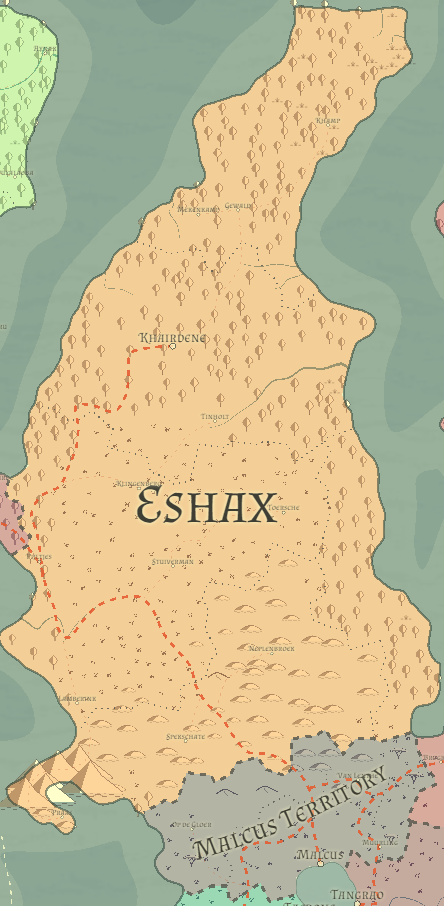Eshax (Ez-sh-axe)
In the late 550s, Eshax was the homeland of the Dulandir and the Anor Humans. When the Wood Elves came to explore their woodlands and make a home for themself, the humans feared that they would be overrun by the Elves. So in a swift motion, many Lords and Lordesses married between Dulandir and Anors to unify themselves as a single unit during the Era of Lordship. When the time came with a sense of divine right, King Martijn van Esjac decreed that the land would come under the rule of his family and that all Lords must bow to his name or be rooted out of the country. Creating the Knights of the Chain, King Esjac claimed the land of Esjac for his namesake to control the land of modern day Eshax. His rule came to be during 1151 and came to rest in 1184, sending the title of Prince King to his son, Roelof Esjac I. Why Martijn van Esjac made his son Prince King instead of King remains lost to history as scholars are still undertaking research into the cause behind this change in title. Prince King Roelof I ruled from 1184 to 1253 continuing the lineage of Prince King with his son, Roelof II.
With the death of Prince King Gert-Jan Esjac in 1533, Prince King Nout van der Wal marked the first time in Eshax recorded history that an Esjac did not take the throne. The van der Wal family was another noble lineage that lorded over the town of Doke underneath the Knights of the Chain since its founding. When the time came for a Prince King to be chosen, the van der Wals were selected from the numerous noble families that sent their sons to be chosen for the throne. Nout van der Wal served faithfully from 1533 until his death in 1578, extending the throne to his son, Issaac van der Wal, on his deathbed. After the death of Prince King Issaac in 1610, not having any children himself, the Knights of the Chain decreed a law that a Prince King would be chosen through a series of games named the Khairdene Bowl, for they take place in the capital city of Khairdene before the ruling Prince King dies.
Notable Prince Kings include Roelof VI, who was the long lost son of the Esjac royal line; Klaas van der Heiden, who participated in the competition to reclaim his throne but was slain by jousting in a terrible accident - the participant that killed him was swiftly convicted of high treason against the Prince King; Piet van Ommen whom most people believed was a vampyre, and disappeared under mysterious circumstances; Sijbrand Lemmers, who finally won the Khairdene Bowl after two years of back to back ties; Willem Otten won two consecutive Khairdene Bowls, finally passing away after his ex-wife Kaatje poisoned his wine, and Joris Nevenzel, the youngest Prince King, ascending to the throne at only 16 years old.
Eshax is obviously not spelled the same as the original founder, Martijn van Esjac, spelled his name. This is attributed to dialect changes, pronunciation, accent changes, and overall incorrect spelling. To this day, Eshax has permanently had its name spelled as it is found so people correctly pronounce the nation and the name of the family that founded it. Notable exports of Eshax include animal products, salt water fish, and whale oils.
The order of Rulers of Eshax are as follows:
King Martijn van Esjac, 1151 – 1184
Prince King Roelof Esjac I, 1184 – 1253
Prince King Roelof Esjac II, 1254 – 1304
Prince King Roelof Esjac III, 1304 – 1392
Prince King Roelof Esjac IV, 1392 – 1420
Prince King Roelof Esjac V, 1420 – 1486
Prince King Quintijn Esjac, 1486 – 1522
Prince King Gert-Jan Esjac, 1522 – 1533
Prince King Nout van der Wal, 1533 – 1578
Prince King Issaac van der Wal, 1578 – 1610
Prince King Daan Katerman, 1610 – 1690
Prince King Sander Beudeker, 1690 – 1766
Prince King Niek Bramer III, 1766 – 1804
Prince King Klaas van der Heiden, 1804 – 1868
Prince King Gustaaf Wooldrik, 1868 – 1924
Prince King Vincent Schut, 1924 – 1975
Prince King Michiel Bruunenburg, 1975 – 2024
Prince King Sjang Rutjes, 2024 – 2073
Prince King Boudewijn van ‘t Schoten, 2073 – 2109
Prince King Sebastiaan Morsche, 2109 – 2180
Prince King Piet van Ommen, 2180 – 2396
Prince King Sijbrand Lemmers, 2398 – 2461
Prince King Willem Otten, 2461 – 2591
Prince King Lars Paskemp, 2591 – 2653
Prince King Jan-Pieter Keuterman, 2653 – 2750
Prince King Kees Verboom, 2750 – 2843
Prince King Twan de Wilde, 2843 – 2899
Prince King Christiaan Nossin XI, 2899 – 2976
Prince King Joris Nevenzel, 2976 – Present Day
The Chain Must Ne'er Be Broken
Type
Geopolitical, Principality
Capital
Alternative Names
Esjac's Territory, Esjacs, Eshacs, Ezjacques
Head of State
Head of Government
Government System
Monarchy, Theocratic
Power Structure
Feudal state
Economic System
Market economy



Comments